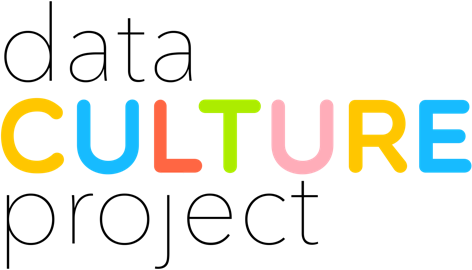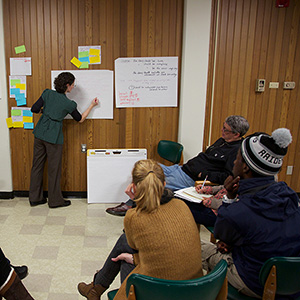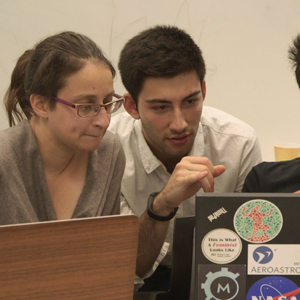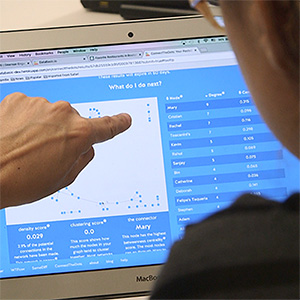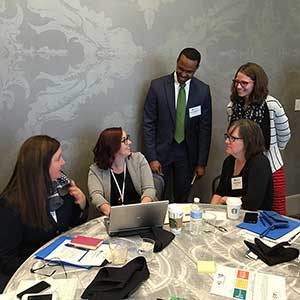Struggling to build your organization's ability to work with data? Use our hands-on learning program to kickstart your data culture.
Data is everywhere right now. But many organizations like yours are struggling to figure out how to build capacity to work with data. You don't need a data scientist; you need a data culture.
This program was accessible to people of all levels
- Jennifer Connolly, Junior Achievement of Western Massachusetts
Use our self-service learning program to facilitate fun, creative introductions for the non-technical folks in your organization. These are not boring spreadsheet trainings. The free tools and activites below are hands-on and designed to meet people where they are across your organization and build their capacity to work with data. Try to kickstart your data culture by running one activity per month as a brown bag lunch. The videos and facilitation guides below will lead you through running them yourself. People at more than 30 organizations have done so already - from a local public library, to the World Food Progam.
How do you build a data culture? Use our videos and guides to run one activity a month at brown bag lunches in your org.
The Data Process
Here's a process we introduce to get you from data to impactful story. Keep scrolling down to learn about the activities we offer for you to run at each step along the way.

Warm Ups
Before jumping into finding data or telling stories, it's important to do some warm ups to activate your organization's data mindset. Warm ups are quick, fun, hands-on activities designed to activate conversation, catalyze creative ideas and build confidence to take the next step. For example, lead colleagues to Build Data Sculptures with craft materials to explore different ways to communicate the same simple data set. Working with pompons, pipe cleaners, or other local materials changes how you approach data, letting you focus on playfully quick ways to look for stories. Deconstruct a dataviz to build your skills in understanding data visualizations, and developing a strong data-driven narrative arc of your own.
Asking Questions
What questions can (and cannot) be answered with data? And once you are staring at some rows and columns, how do you start to make sense of the data in front of you? In this stage, you learn to take the first step in the data analysis process by asking good questions. Use WTFcsv to quickly summarize spreadsheet data, brainstorm questions about it, potential connections to other data sets, and potential biases you might bring to it. Remember – the data never speaks for itself – you help it speak by asking better and better questions. Fill in a Paper Spreadsheet to introduce people to various types of data and help them think about how people fill it in.
Gathering Data
Often you don’t recognize the data you already have! Data is all around, but can be difficult to identify and describe. You need the right data to tell a strong story. As they say, “garbage in, garbage out.” You also need to remember that a single data set may not be able to answer your questions. Combining datasets is often the best way to create a more fleshed out story. Use Connect the Dots to explore crowd-sourcing data from your audience to analyze together as a network. Or Use WTFcsv to think about how to gather the data you need to answer a question.
Analyzing Data
Data can be intimidating, especially when it comes to analyzing it. But remember, most of statistics is just special ways of counting. We’re all pretty good at counting! Establishing a data culture doesn't mean that we will all be statistical wizards but it does mean learning enough about analysis to understand its creative potential. The data analysis process is an opportunity to bring people together. There are many ways to do this to find a story. Use WordCounter to learn about analyzing text data to find stories. Use Connect the Dots to collaboratively analyze a network graph. Use SameDiff to learn about how algorithms can help you analyze data in more abstract ways.
Telling Your Story
Telling your story is where the rubber hits the road. Numbers alone are not enough to make your case or move people to action. You have to give your data some context, and stitch it together into a narrative so that people can understand it. Sketch a story with WordCounter to practice communicating a data-driven story visually. Make a Word Web to move from abstract ideas and numbers into concrete visual symbols. Remix an Infographic to practice telling the same story in diffferent ways.
Try It Out
How do you know if your story is working? Does the data you included support the narrative you are telling? It can be very difficult to put yourself in the shoes of your audience and try to understand what kind of story will change their worldview or move them to action. And you might have multiple audiences. Each potential audience brings different beliefs and experiences to understanding your message. Try out ConvinceMe to practice telling different stories to different audiences. Write a Data Storybook to practice writing compelling narrative arcs that are supported by the data you are working with.
Connect with Others
Trying to build a data culture can be a lonely effort in organizations that haven't recognized the importance of data. Join the Data Culture discussion group to connect with others and reflect on how these activities are working, or not working, for your organization.
Join the discussion groupAbout Us
The Data Culture Project is an initiative of DataBasic.io. We’ve pulled together the years of work with nonprofits into one place to help you build a data culture. DataBasic.io is the brainchild of Catherine D’Ignazio and Rahul Bhargava.
